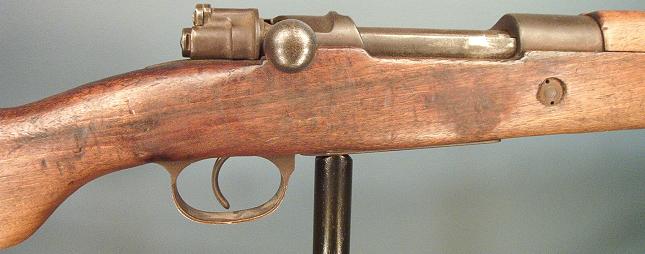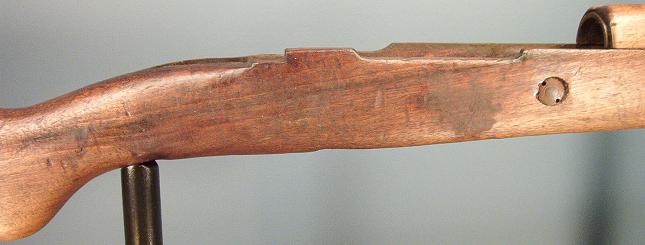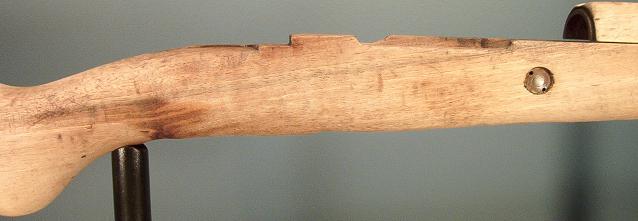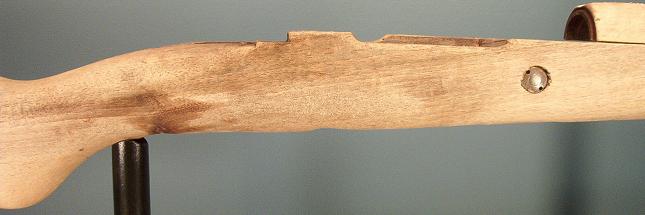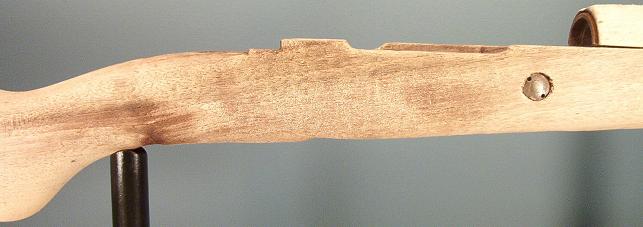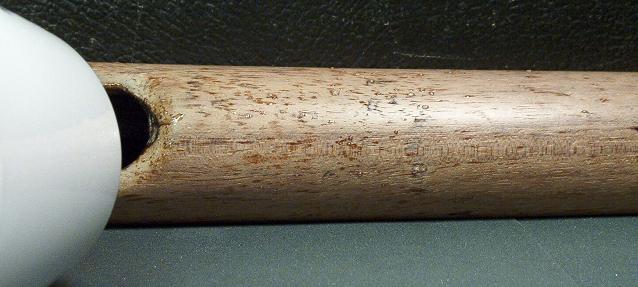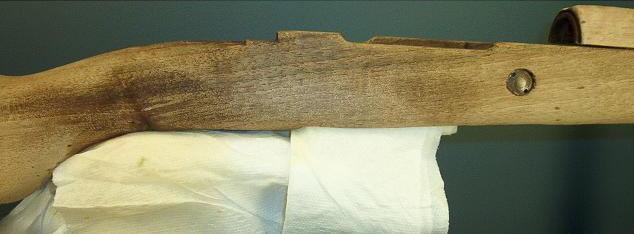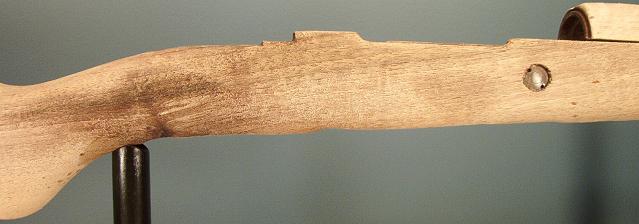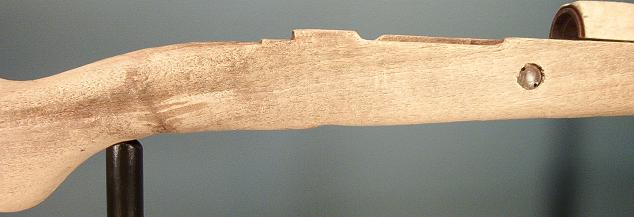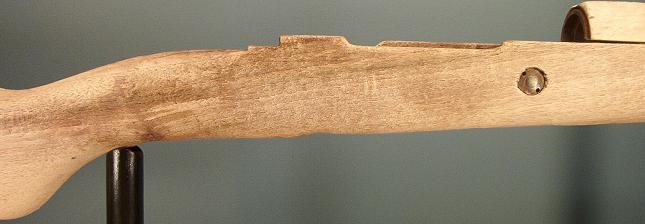1940 Turkish Model 1903 Mauser Rifle
This gun makes an excellent demonstration example because the stock is very dirty and heavily soaked with grease and oil. Because it is made of a light colored wood, Beech I believe, it will show dark areas well to indicate the effectiveness of the various cleaning methods.
Before and after disassembly
Gentle Cleaning
The minimum cleaning consists of wiping the stock with a soft cloth dampened with a solution that will aid in removing surface dirt, grease, and oil. For Oil Finishes that contain no varish or other solutions, the most gentle cleaning consists of wiping the stock with a small amount of the oil that the stock was finished in. That is, if the finish is Linseed Oil, Boiled Linseed Oil is used or, if the finish is Tung Oil, Pure Tung Oil is used. For Oil/Varnish Finishes that indicate in the directions to do so, a small amount of the Oil/Varnish Finish that the stock was finished in is used to clean the stock. For Varnish, Laquer, Polyurethane or other sealed finishes, a small amount of WD-40 may be used to clean the stock.
A bit harsher, but more thorough, cleaning method consists of wiping the stock with Mineral Spirits. Mineral Spirits will not cause the grain to raise but, depending on the type of finish, may remove a small amount of the finish.
Thorough Cleaning Methods
The harsher but more thorough cleaning methods described in the sections below include the use of water that will cause the grain to raise. Virtually all minor dents in the wood are also very effectively removed by these cleaning methods. After complete disassembly, each cleaning method below will be performed on this gun stock in the order given with the results of each method shown. The three methods used follow in order of the most to least gentle (least to most harsh, i.e. effective):
1. Wash with Murphy Oil Soap
2. Wash with Oven Cleaner (e.g. EASY-OFF)
3. Wash in Dishwasher
Materials Needed
1. Cleaning Solution To Be Used
2. Hot Water Source
3. Brushes
4. Wet/Dry Shop Vacuum
NOTE: Read, understand, and follow all product labeling precautions and directions.
Method 1: Murphy Oil Soap
This method is used to gently remove surface dirt, grease, and oil.
A. Scrub stock thoroughly with Murphy Oil Soap.
B. Rinse with hot water while scrubbing.
C. Extract excess moisture using Wet/Dry Shop Vacuum.
D. Allow to dry.
The results are shown below after allowing to dry for 24 hours:
Note that the stock appeared virtually oil free after initial cleaning. However, after approximately one hour, the dark portions started appearing as a result of embedded oil rising to the surface.
Method 2: Oven Cleaner
This method is used to strip all the finish and to remove a portion of embedded oil. Read, understand, and follow all Oven Cleaner precautions and directions.
Oven Cleaner (sodium hydroxide) is in some ways more gentle than Paint And Varish Removers (methylene chloride also called dichloromethane) because it can be used to strip paint from plastic (polystyrene) models without harming the plastic, whereas Paint And Varish Removers will melt the plastic. However, Oven Cleaner can remove natural oils and can cause surface wood fibers to separate and can cause the wood to turn darker.
A. Spray stock with Oven Cleaner per directions and allow to soak for 10 minutes.
B. Rinse with water while scrubbing.
C. Spray with Oven Cleaner again and scrub.
D. Scrub thoroughly with Dawn Dish Soap.
E. Rinse with hot water while scrubbing.
F. Extract excess moisture using Wet/Dry Shop Vacuum.
The results are shown below after allowing to dry for 24 hours:
Note that once again the stock appeared virtually oil free after initial cleaning. However, after approximately one hour, the dark portions started appearing as a result of embedded oil rising to the surface:
Method 3: Dishwasher
This method is used to remove chemical residues and/or a portion of embedded oil.
A. Wash the stock in Dishwasher but do not run through dry cycle.
B. Rinse with hot water while scrubbing.
C. Extract excess moisture using Wet/Dry Shop Vacuum.
D. Allow to dry.
If the stock is too large to fit into the Dishwasher, the stock may be scrubbed with Dawn Dish Soap and then sprayed with a high pressure wand, similar to those at a typical Car Wash, using the hot rinse cycle. Do not spray too close to the stock to prevent damaging the wood.
Since this stock was too large to fit into the Dishwasher, it was washed using Dawn Dish Soap and a high pressure wand at the Car Wash. The photo below was taken immediately after washing the stock:
The results are shown below after allowing to dry for 48 hours:
Notice that once again the stock appeared virtually oil free after initial drying. However, the dark portions started appearing as a result of embedded oil rising to the surface.
Determine Oil Remaining
To determine how effectively the above methods have extracted oil, and to extract even more oil, the stock is heated and oil rising to the surface is removed.
Materials Needed
1. Heating Source
2. Thermometer
3. Paper Towels
4. Rubber BandsProcedure
Heat is used to cause the oil to expand and rise to the wood surface where it can be absorbed by paper towels. It is possible to have the oil absorbed as soon as it rises to the surface by wrapping the stock tightly in several layers of paper towels and then wrapped with rubber bands. Heating sources that may be used are described in the sections below.Portable Hair Dryer
The photo below shows the results after heating with a Portable Hair Dryer for several minutes. Note the small droplets of oil rising to the surface:
Microwave Oven
Heat for approximately 15 to 25 seconds at a time and use extreme caution to not burn or possibly crack the wood. Do NOT microwave for more than 25 seconds at a time and note that the maximum time to microwave is less for smaller items. The photo below shows the results immediately after removing the handgard from the Microwave Oven after heating for 25 seconds. Note the oil boiling out of the end grain:60 Watt Light Bulbs
Repeat As Necessary
If an unacceptable amount of oil is remaining in the stock, repeat Method 1 above and once again acquire an indication of the amount of oil remaining in the stock. This particular stock is heated only once at 120 degrees for 12 hours for this demonstration.
Method 1 above is the final step to cleaning the gun stock. Allow plenty of time to dry before preparing stock for finish. Final Step
The stock before performing the final step is shown below:
The result of washing the stock in Murphy Oil Soap (Method 1) soon after initial drying is shown below. Note how the stock appears mainly oil free:
The results are shown below after allowing to dry for 24 hours. Note how more embedded oil has risen to the surface:
The result of cleaning this stock using the above methods is shown below: Final Results



